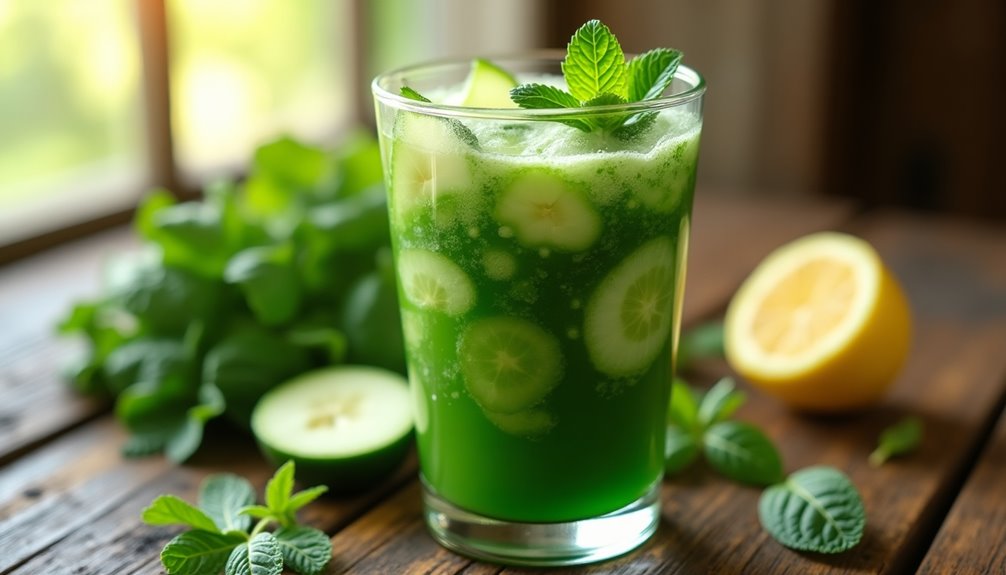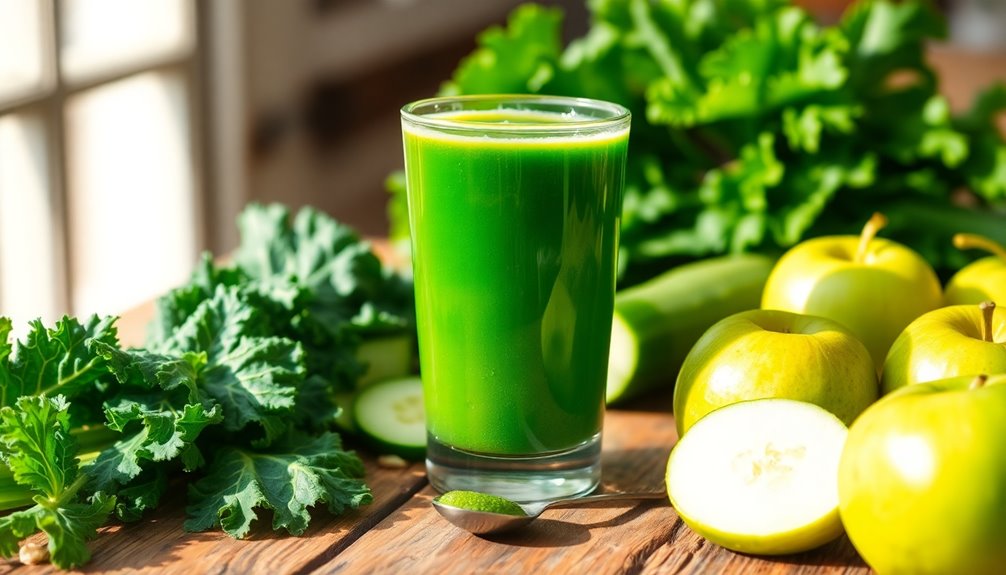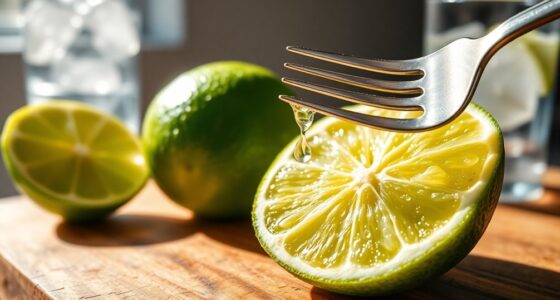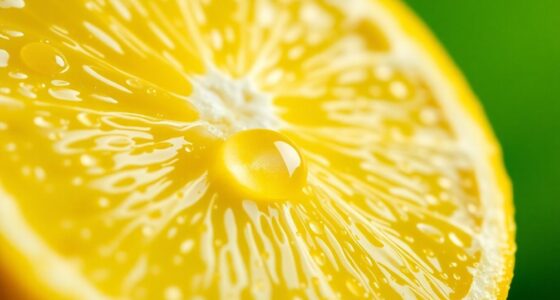Green juice usually contains about 126 calories per serving, but this can vary between 84 to 217 calories depending on the ingredients you use. Leafy greens and low-sugar fruits help lower the calorie count, while higher-sugar fruits or added extras can raise it. The good news is that despite the calories, green juice packs a punch of vitamins and minerals that can boost your health. For more insights into its nutritional benefits, keep going! Moreover, green juice is typically rich in antioxidants, which are essential for fighting oxidative stress in the body. If you’re curious about specific calorie content, you might ask, “how many calories in green juice? ” Understanding this can help you make informed choices about incorporating it into your diet while maximizing its nutritional benefits. Always remember to balance your intake with other healthy foods to achieve the best results for your overall wellness.
Key Takeaways
- A typical serving of green juice contains about 126 calories, but this can vary widely.
- Calorie count ranges from approximately 84 to 217 calories per cup, depending on ingredients.
- Leafy greens and low-sugar fruits help keep the calorie count lower.
- Higher-sugar fruits or added ingredients will increase the total caloric content of the juice.
- Monitoring ingredient choices is essential for understanding the nutritional value and calorie count of homemade or store-bought green juice.

Have you ever wondered how many calories are packed into your green juice? If you're sipping on a typical serving, you're consuming about 126 calories. That's not too bad, especially when you consider the benefits it brings. Green juice is often celebrated for its nutrient density, which can make it a fantastic addition to your diet.
With a well-balanced blend of leafy greens and fruits, it can provide essential vitamins and minerals that your body craves. When you dive deeper into the macronutrient breakdown, you'll find that green juice is primarily made up of carbohydrates, accounting for about 89% of its total content. This high carbohydrate percentage is largely due to the natural sugars derived from the fruits and vegetables included in the juice.
Speaking of sugars, one serving offers 22 grams of total sugars. But don't worry; these sugars are primarily from natural sources, which means they come with a host of nutrients rather than empty calories. One of the standout features of green juice is its impressive vitamin C content. In fact, a single serving provides a whopping 96% of the Daily Value for this vital nutrient.
Vitamin C is crucial for maintaining a healthy immune system, aiding in the absorption of iron, and promoting skin health. So, when you drink your green juice, you're not just getting a refreshing drink; you're also giving your body a boost in nutrition. Now, if you're making your own green juice at home, the calorie count can vary quite a bit, ranging from approximately 84 to 217 calories per cup.
This variation largely depends on the ingredients you choose to include. If you stick to leafy greens and low-sugar fruits, you can keep the calorie count lower. However, adding higher-sugar fruits or other ingredients will naturally increase the total calories. It's a good idea to keep an eye on the nutrition labels or calculate the calories in your homemade concoction to stay informed.
As you enjoy your green juice, remember that it's not just about calories; it's about the overall nutrition you're getting. In addition to vitamin C, you're likely consuming a variety of other vitamins and minerals that support your health. The combination of leafy greens, fruits, and other ingredients gives you a powerful way to nourish your body while enjoying a tasty beverage.
Frequently Asked Questions
Is Green Juice High in Calories?
You might be wondering if green juice is high in calories. The good news is, it's actually a low-calorie beverage option.
With around 126 calories per serving, it won't contribute much to your daily intake. Most of its calories come from carbohydrates, while it's low in fat.
Plus, you'll get a boost of vitamins, especially vitamin C, making it a refreshing and healthy choice without packing on the calories.
Is It OK to Drink Green Juice Everyday?
Yes, it's perfectly fine to drink green juice every day! It offers a great way to boost your vitamin intake, especially vitamin C, while being low in calories.
The fiber content supports your digestive health, and it helps meet your potassium needs.
However, remember to balance your diet with whole fruits and vegetables to ensure you're getting enough fiber and a diverse range of nutrients.
Enjoy your daily green juice as part of a healthy lifestyle!
How Many Calories in a Green Detox Juice?
You might think green detox juice is a low-calorie miracle, but it packs around 126 calories per serving.
Surprised? Most of those calories come from carbohydrates, with a splash of fat and protein thrown in.
It's rich in dietary fiber and vitamin C, too, giving you a healthy boost.
How Many Calories Are in 8 Oz of Green Juice?
When you pour yourself an 8 oz serving of green juice, you're looking at roughly 126 calories.
This beverage packs a punch with its macronutrient breakdown—89% carbohydrates, 5% fat, and 6% protein.
You'll also get about 22 grams of total sugars. Plus, it's a fantastic source of vitamin C, providing almost all of your Daily Value.
Just remember, the exact calories can change based on the specific ingredients you choose!
Conclusion
So, the next time you sip on that vibrant green juice, remember it's not just a refreshing drink but a low-calorie powerhouse. Coincidentally, it might just be the boost you need to fuel your day. With each gulp, you're not only nourishing your body but also delighting your taste buds. Who knew that something so delicious could also be so kind to your waistline? Keep enjoying that green goodness, and watch how it transforms your health journey!
Cindy thoroughly researches juicing trends, techniques, and recipes to provide readers with practical advice and inspiration. Her writing style is accessible, engaging, and designed to make complex concepts easy to understand. Cindy’s dedication to promoting the advantages of juicing shines through her work, empowering readers to make positive changes in their lives through the simple act of juicing.











